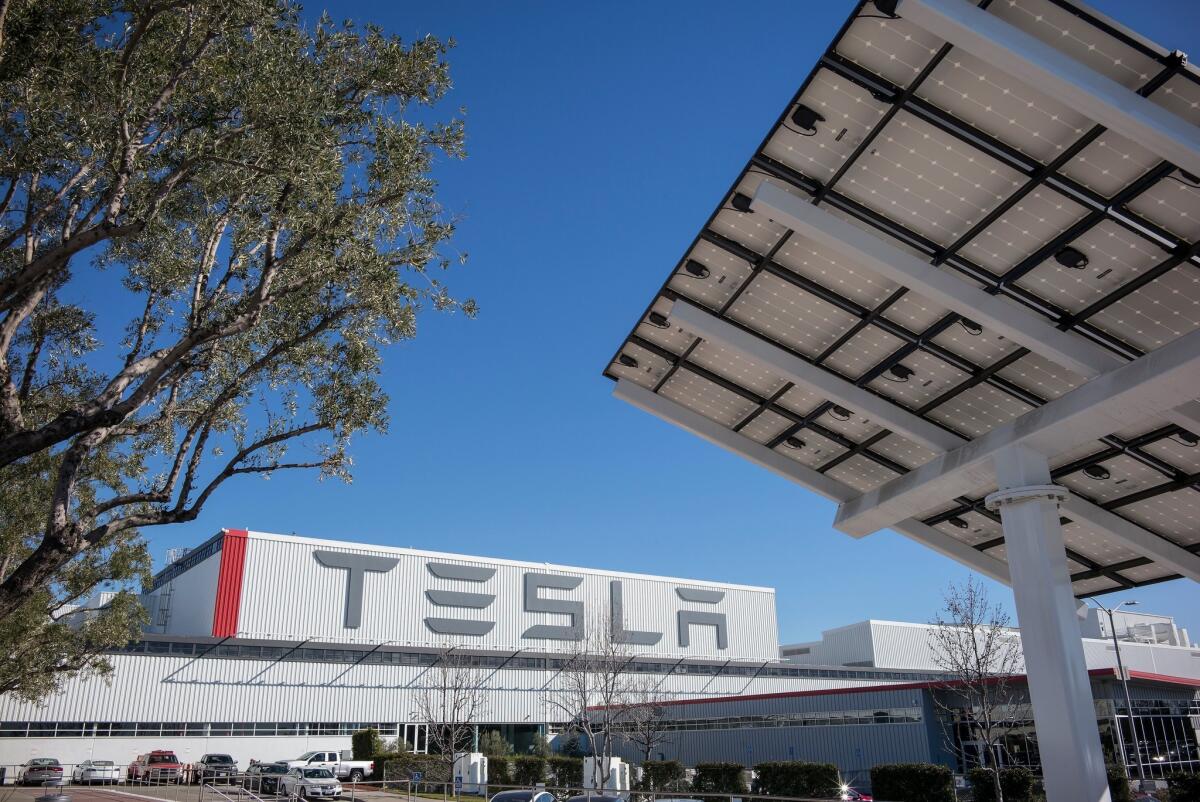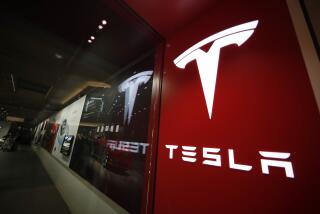Tesla’s first-quarter loss widens amid heavy spending

Electric car maker Tesla says it lost $154 million in the first quarter, compared with a loss of $49.8 million a year earlier. Revenue rose 51% to nearly $940 million. Above, Tesla’s car factory in Fremont, Calif.
- Share via
Tesla Motors Inc. reported a dramatically wider loss in the first quarter as it spent heavily to launch a new sport utility vehicle, rebuild its paint shop and construct a giant battery plant near Reno.
The Palo Alto electric car company said it lost $154 million in the first quarter, compared with a loss of $49.8 million a year earlier. First-quarter revenue rose 51% to nearly $940 million.
Tesla’s results were also dragged down from $22 million in mostly unrealized losses from revaluation of its foreign currency holdings because of the strong dollar.
The company continued to offer a rosy outlook for the second quarter, however. It expects to produce about 12,500 vehicles, roughly a 12% gain from the previous quarter, and is on track to deliver 55,000 Model S and Model X vehicles this year.
The Model S is its luxury sedan and flagship model, which typically sells for about $100,000. It plans to start deliveries of the Model X electric sport utility vehicle, expected to have a similar price, late in the third quarter.
“There are huge advance orders for the X and we see a steady climb in demand for the Model S,” said Elon Musk, Tesla’s chief executive.
Selling government-awarded environmental credits continues to be a steady source of revenue for the automaker. It sold an additional $66 million worth of credits during the first quarter, including $51 million of special California zero-emission vehicle credits.
Other automakers purchase the credits to meet the state’s environmental regulations. Tesla’s total take from selling the credits now amounts to more than $500 million.
Despite the quarterly loss, analysts said Tesla was making progress ramping up its car production and designing future models, including the Model X and the Model 3, a smaller, less expensive electric car that Musk said would hit the market in 2017.
Shares in the company rose 2% to $235 in after-market trading. Tesla released its report after the close of the stock market Wednesday afternoon.
The shares rose because Tesla’s total loss was lower under a different accounting rubric preferred by the company and some analysts, said Dan Dolev, an analyst with Jefferies Equity Research.
Using so-called non-GAAP accounting, Tesla posted a first-quarter loss of $45.2 million, compared with a profit of $17 million a year earlier. Those figures include deferred profits on leased cars and exclude certain non-cash expenses, such as stock-based compensation.
“You buy this stock on the expectation they will be making a lot of money in the future,” Dolev said. “You don’t buy on whether they are making money in this particular quarter.”
Tesla’s financial report indicated that demand for its cars is strong, deliveries were greater than the company had previously estimated, revenue is growing quickly and it has slashed the amount of labor hours per car by 20%, he said.
“This is like making a bet on Amazon in 1999,” Dolev said.
Others were more cautious in their assessment, in part because Tesla’s cash reserves plunged to $1.5 billion in the first quarter from nearly $2.4 billion a year earlier.
“The company is burning through its cash reserves, and it’s never been profitable,” said Karl Brauer, an analyst with auto information company Kelley Blue Book.
He noted that the money pouring into the giant battery factory and the plan Tesla announced last week to dive into the energy storage business would take time to make a return on investment.
And the Model 3, which will sell for about $35,000, is still years away.
“Does the company risk running out of money before these long-term projects pay off?” Brauer asked.
Twitter: latimesjerry
More to Read
Inside the business of entertainment
The Wide Shot brings you news, analysis and insights on everything from streaming wars to production — and what it all means for the future.
You may occasionally receive promotional content from the Los Angeles Times.










